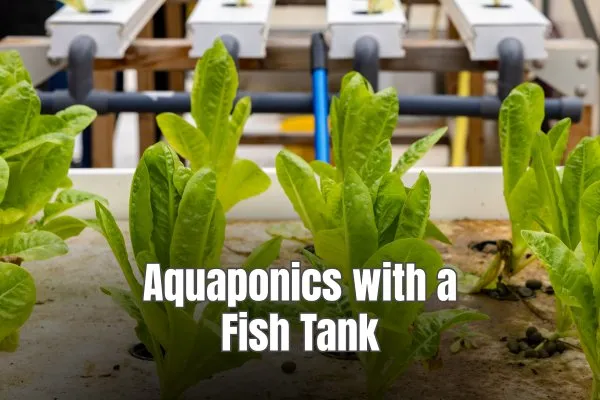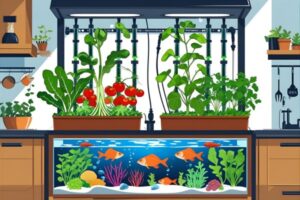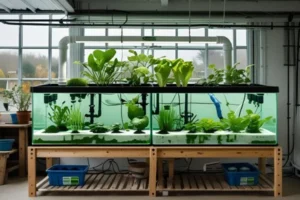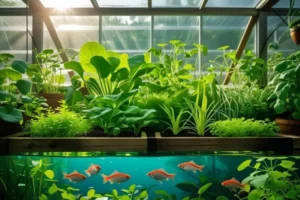Aquaponics with a fish tank represents one of the most rewarding and sustainable ways to grow fresh food at home. This innovative farming method combines fish farming (aquaculture) with soilless plant cultivation (hydroponics), creating a symbiotic ecosystem where fish waste provides natural fertilizer for plants, while plants filter and clean the water for fish.
The popularity of home aquaponics has exploded in recent years, with over 2.3 million Americans now growing food using soilless methods. What makes aquaponics with a fish tank particularly appealing is its dual production capability – you harvest both fresh vegetables and protein-rich fish from a single, integrated system. Unlike traditional gardening, this method uses 90% less water while producing food year-round, regardless of climate or soil conditions.
However, many beginners face significant confusion when choosing and managing fish tanks for their aquaponics systems. Common questions plague newcomers: What size tank do I need? Which fish species work best? How do I maintain proper water quality? What equipment is essential? These uncertainties often lead to costly mistakes, fish mortality, and system failures that discourage people from continuing their aquaponics journey.
The fish tank serves as the heart of your aquaponics system – it’s where the magic begins. Fish produce ammonia-rich waste that beneficial bacteria convert into nitrites, then nitrates, which plants absorb as nutrients. This natural nitrogen cycle creates a self-sustaining ecosystem that, when properly managed, requires minimal external inputs while producing maximum outputs.
Whether you’re planning a small 20-gallon (75.7 L) desktop system for herbs or a larger 300-gallon (1,135.6 L) setup for feeding your family, understanding fish tank fundamentals is crucial for success. The wrong tank choice can limit your production, increase maintenance, and create ongoing problems that frustrate even dedicated growers.
This comprehensive guide eliminates the guesswork by providing clear, actionable information for setting up and managing aquaponics with a fish tank. You’ll discover the optimal tank sizes for different goals, learn which fish species thrive in home systems, master the step-by-step setup process, and gain the knowledge to troubleshoot common problems before they become disasters.
By the end of this article, you’ll have the confidence and knowledge to create a thriving aquaponics system that produces fresh food while providing the satisfaction of managing a living, breathing ecosystem in your own home.
Understanding Fish Tank Requirements for Aquaponics
Selecting the right fish tank is fundamental to aquaponics success, as it directly impacts fish health, system stability, and overall production capacity. The tank serves as the foundation of your nitrogen cycle, making proper sizing and material selection critical decisions that will affect your system for years to come.
Tank Size Guidelines
Tank size determines both fish capacity and nutrient production for your plants. For small-scale home systems, a 50-gallon (189.3 L) tank supports 10-15 lbs (4.5-6.8 kg) of fish and can feed approximately 20-30 plants. Medium systems using 100-150 gallon (378.5-567.8 L) tanks accommodate 20-35 lbs (9.1-15.9 kg) of fish, supporting 40-60 plants effectively.
Large home systems require 200-300 gallon (757.1-1,135.6 L) tanks, housing 40-70 lbs (18.1-31.8 kg) of fish and feeding 80-120 plants. The general rule follows a 1:1 ratio – one gallon of fish tank capacity per pound of fish at harvest weight. However, this assumes proper filtration, aeration, and water quality management.
Tank Materials and Durability
Food-grade materials are essential for aquaponics fish tanks. High-density polyethylene (HDPE) tanks offer excellent durability, UV resistance, and chemical inertness, making them ideal for outdoor systems. These tanks typically cost 1.50−3.00 USD per gallon and last 15-20 years with proper care.
Fiberglass tanks provide superior insulation and longevity but cost 3.00−5.00 USD per gallon. They’re excellent for temperature-sensitive fish species and systems in extreme climates. Avoid galvanized steel, copper, or treated wood tanks, as these materials can leach harmful chemicals that poison fish and disrupt beneficial bacteria.
Tank Shape and Water Flow
Round or oval tanks promote better water circulation than rectangular designs. Circular tanks create natural water movement that prevents dead zones where waste accumulates and oxygen levels drop. This improved circulation reduces cleaning requirements and maintains more stable water quality.
Tank depth affects oxygen levels and fish behavior. Depths of 18-24 inches (45.7-61.0 cm) work well for most species, providing adequate swimming space while maintaining efficient heating and cooling. Deeper tanks require more powerful pumps and aeration systems, increasing operational costs.
Production Capacity Planning
Calculate your tank needs based on desired harvest goals. A family of four consuming 2 lbs (0.9 kg) of fish monthly needs approximately 24 lbs (10.9 kg) of fish annually. With tilapia reaching 1-2 lbs (0.5-0.9 kg) at harvest, you’ll need 12-24 fish, requiring a minimum 150-gallon (567.8 L) tank for optimal growth rates and water quality stability.
Best Fish Species for Tank-Based Aquaponics
Choosing the right fish species determines your system’s success, affecting everything from water quality stability to harvest yields. Different species have varying temperature requirements, growth rates, and waste production levels that directly impact plant nutrition and system management complexity.
Tilapia: The Aquaponics Champion
Tilapia dominates home aquaponics due to exceptional hardiness and rapid growth. These fish tolerate temperature ranges of 60-86°F (15.6-30.0°C), though they thrive best at 75-82°F (23.9-27.8°C). Tilapia reach harvest weight of 1-2 lbs (0.5-0.9 kg) in 6-9 months, producing excellent waste-to-nutrient conversion for plant growth.
Blue tilapia and Nile tilapia are top choices for beginners. They survive pH fluctuations between 6.0-8.5, handle temporary oxygen drops, and resist common diseases. Stock 1 fish per 5-10 gallons (18.9-37.9 L) initially, allowing growth space. A 100-gallon (378.5 L) tank supports 10-20 juvenile tilapia comfortably.
Trout: Cool-Water Excellence
Rainbow trout excel in cooler climates, preferring water temperatures of 50-65°F (10.0-18.3°C). They grow rapidly, reaching 8-12 inches (20.3-30.5 cm) in 12-18 months, and produce high-quality protein with excellent flavor profiles. Trout require higher oxygen levels (6-8 ppm) and pristine water quality, making them suitable for experienced growers.
Stock trout at 1 fish per 10-15 gallons (37.9-56.8 L) due to their higher oxygen demands. A 150-gallon (567.8 L) system supports 10-15 trout effectively. Their waste production creates excellent plant nutrition, particularly benefiting leafy greens and herbs that prefer cooler growing conditions.
Catfish: Hardy and Productive
Channel catfish offer exceptional hardiness and tolerance for varying water conditions. They survive temperatures from 45-85°F (7.2-29.4°C) and handle pH ranges of 6.5-8.5 without stress. Catfish reach 1-3 lbs (0.5-1.4 kg) in 12-18 months, providing substantial harvests for larger families.
These bottom-feeders help clean tank debris while producing nutrient-rich waste. Stock 1 catfish per 15-20 gallons (56.8-75.7 L) as they grow larger than tilapia. Their calm nature reduces stress-related diseases, making them excellent choices for outdoor systems with temperature fluctuations.
Ornamental Fish for Small Systems
Goldfish and koi work excellently in smaller desktop systems where food fish aren’t practical. Goldfish thrive in 20-50 gallon (75.7-189.3 L) tanks, tolerating temperatures from 50-75°F (10.0-23.9°C). They produce sufficient waste for 10-20 small plants while providing visual appeal and educational value for families with children.
Step-by-Step Fish Tank Setup
Setting up your aquaponics fish tank requires careful planning and proper sequencing to create a stable, thriving ecosystem. This systematic approach ensures your fish have optimal conditions while establishing the biological foundation for successful plant production.
Essential Equipment and Materials
Begin by gathering all necessary components before starting installation. You’ll need a food-grade tank (50-300 gallons/189.3-1,135.6 L depending on your goals), a water pump rated for your system volume, air pump with diffuser stones, water heater (100-300 watts depending on tank size), and basic water testing kit measuring pH, ammonia, nitrite, and nitrate levels.
Additional equipment includes PVC plumbing fittings, flexible tubing, tank insulation for temperature control, and a backup power source for critical components. Budget $300-800 USD for a complete 100-gallon (378.5 L) setup, including all essential equipment and initial fish stock.
Tank Placement and Preparation
Position your tank on a level, stable surface capable of supporting 8.34 lbs per gallon (1.0 kg per liter) of water weight. A 100-gallon (378.5 L) system weighs approximately 834 lbs (378.3 kg) when full. Ensure access to electrical outlets and protection from extreme temperature fluctuations.
Clean the tank thoroughly with water only – never use soap or chemicals that could harm fish or beneficial bacteria. Install the water heater, air pump, and circulation pump according to manufacturer specifications. Test all equipment before adding water to prevent electrical hazards and ensure proper operation.
Water Conditioning and Cycling Process
Fill the tank with dechlorinated water, allowing chlorine to evaporate for 24-48 hours or using water conditioner to neutralize chemicals immediately. Maintain water temperature at 75-80°F (23.9-26.7°C) for optimal bacterial growth during cycling.
The cycling process establishes beneficial bacteria that convert fish waste into plant nutrients. Add ammonia source (fish food or pure ammonia) to reach 2-4 ppm concentration. Monitor ammonia, nitrite, and nitrate levels daily. Expect ammonia to peak at days 7-14, followed by nitrite spikes at days 14-21. Complete cycling occurs when ammonia and nitrites drop to zero while nitrates remain present, typically requiring 4-6 weeks.
System Integration and Testing
Connect your fish tank to the plant growing beds using appropriately sized pumps and plumbing. Water should flow from the fish tank through plant beds and return via gravity or sump pump systems. Calculate flow rates at 1-2 times tank volume per hour for optimal nutrient distribution and oxygenation.
Test all connections for leaks and verify proper water circulation throughout the entire system. Adjust flow rates and add backup aeration if needed. Once cycling completes and water parameters stabilize, gradually introduce fish over 2-3 days, starting with 25% of planned stock to avoid overwhelming the biological filter.
Tank Management and Water Quality
Maintaining optimal water quality in your aquaponics fish tank requires consistent monitoring and proactive management. Water parameters directly affect fish health, bacterial activity, and plant nutrition, making quality control the cornerstone of successful aquaponics operations.
Critical Water Parameters
pH levels between 6.8-7.2 provide the optimal balance for fish health, bacterial efficiency, and plant nutrient uptake. Test pH weekly using digital meters or test strips, adjusting with potassium hydroxide to raise or phosphoric acid to lower levels gradually. Never change pH more than 0.2 units per day to avoid shocking fish and beneficial bacteria.
Ammonia should remain at 0 ppm in established systems, as levels above 1 ppm become toxic to fish. Nitrite levels must stay below 0.5 ppm, while nitrates should range from 20-40 ppm to provide adequate plant nutrition. Test these parameters twice weekly during the first three months, then weekly once the system stabilizes.
Temperature control varies by fish species but generally stays within 70-80°F (21.1-26.7°C) for tilapia systems. Install aquarium heaters rated at 5 watts per gallon for consistent temperature maintenance. Monitor dissolved oxygen levels, maintaining 5-8 ppm through adequate aeration and water circulation.
Daily and Weekly Monitoring Routines
Perform daily visual inspections of fish behavior, appetite, and water clarity. Healthy fish swim actively, respond to feeding, and display vibrant colors. Cloudy water indicates bacterial blooms or overfeeding, while fish gasping at the surface suggests oxygen deficiency requiring immediate aeration adjustments.
Weekly water testing should include pH, ammonia, nitrite, nitrate, and temperature measurements. Record all readings in a logbook to identify trends and potential problems before they become critical. Monthly testing should include dissolved oxygen, alkalinity, and hardness levels for comprehensive system health assessment.
Feeding Management and Waste Control
Feed fish 1-2% of their body weight daily, divided into 2-3 smaller meals to improve digestion and reduce waste production. A 100-gallon (378.5 L) tank with 20 lbs (9.1 kg) of fish requires approximately 0.2-0.4 lbs (91-181 g) of food daily. Use high-quality aquaculture feed with 32-40% protein content for optimal growth and waste nutrient conversion.
Remove uneaten food within 30 minutes to prevent water quality degradation. Overfeeding causes ammonia spikes, bacterial blooms, and oxygen depletion that can kill fish within hours. Adjust feeding amounts based on water temperature, as fish metabolism slows in cooler conditions requiring reduced food quantities.
Water Changes and System Maintenance
Perform 10-20% water changes weekly to remove accumulated dissolved solids and maintain water quality. Replace evaporated water daily to maintain consistent system volume and prevent concentration of dissolved minerals. Use dechlorinated water matching system temperature to avoid shocking fish and bacteria.
Clean tank walls monthly to remove algae buildup while preserving beneficial bacterial colonies on surfaces.
Common Problems and Solutions
Even well-managed aquaponics systems encounter challenges that can threaten fish health and system productivity. Understanding common problems and their solutions enables quick intervention, preventing minor issues from becoming system disasters that result in fish mortality and crop losses.
Cloudy Water and Bacterial Blooms
Cloudy water typically indicates bacterial blooms caused by overfeeding, inadequate filtration, or system imbalances. When beneficial bacteria cannot process organic waste fast enough, harmful bacteria multiply rapidly, consuming oxygen and producing toxins. This condition can kill fish within 24-48 hours if left untreated.
Immediate solutions include stopping feeding for 24-48 hours, increasing aeration to maximum capacity, and performing 25-30% water changes daily until clarity returns. Long-term prevention requires reducing feeding amounts by 50%, improving mechanical filtration, and ensuring adequate beneficial bacteria populations through proper system cycling.
Add beneficial bacteria supplements (available at aquarium stores for $15-25 USD) to accelerate recovery. Monitor ammonia and nitrite levels closely, as bacterial blooms often coincide with nitrogen cycle disruptions requiring immediate intervention to prevent fish losses.
Fish Mortality and Stress Indicators
Sudden fish deaths usually result from water quality problems, disease outbreaks, or environmental stress. Early warning signs include fish gasping at the surface, erratic swimming patterns, loss of appetite, and visible lesions or discoloration. Temperature fluctuations exceeding 5°F (2.8°C) daily can stress fish severely, compromising immune systems.
Test water parameters immediately when fish show stress signs. Ammonia or nitrite spikes require emergency water changes of 50-75% using dechlorinated water at matching temperature. Install backup aeration systems to prevent oxygen depletion during power outages, as fish can suffocate within 2-4 hours without adequate oxygenation.
Quarantine new fish for 2-3 weeks before introducing them to established systems. This prevents disease transmission that can devastate entire fish populations. Maintain water temperature stability using aquarium heaters and insulation, particularly during seasonal transitions.
Conclusion
Aquaponics with a fish tank offers an incredible opportunity to produce fresh food sustainably while creating a fascinating ecosystem in your own home. Throughout this guide, we’ve explored the essential elements that transform a simple fish tank into the heart of a productive aquaponics system capable of feeding your family year-round.
The key takeaways for success center on proper planning and consistent management. Tank sizing directly impacts your production capacity – remember the 1:1 ratio of one gallon per pound of fish at harvest weight, with 100-150 gallon (378.5-567.8 L) systems providing excellent starting points for most families. Material selection matters significantly, with food-grade HDPE and fiberglass tanks offering the durability and safety your fish require for long-term health.
Fish species selection determines your system’s resilience and productivity. Tilapia remains the gold standard for beginners, tolerating temperature ranges of 60-86°F (15.6-30.0°C) and pH fluctuations between 6.0-8.5, while producing rapid growth and excellent waste-to-nutrient conversion. For cooler climates, trout provide premium protein with their preference for 50-65°F (10.0-18.3°C) water temperatures.
The setup process requires patience, particularly during the 4-6 week cycling period that establishes beneficial bacteria populations. This biological foundation converts fish waste into plant nutrients, creating the symbiotic relationship that makes aquaponics so efficient. Rushing this process leads to system failures and fish mortality that discourage many beginners.
Water quality management represents your daily responsibility as an aquaponics practitioner. Maintaining pH between 6.8-7.2, keeping ammonia at 0 ppm, and ensuring adequate dissolved oxygen levels of 5-8 ppm creates the stable environment where both fish and plants thrive. Weekly testing and consistent monitoring prevent small problems from becoming system disasters.
Common challenges like cloudy water, fish stress, and oxygen depletion have proven solutions when addressed quickly. The key lies in understanding early warning signs and maintaining backup systems for critical components like aeration and temperature control.
Your aquaponics journey begins with a single step – choosing the right fish tank for your goals and space. Whether you start with a modest 50-gallon (189.3 L) desktop system for herbs or commit to a 300-gallon (1,135.6 L) family food production setup, the principles remain consistent: proper planning, quality equipment, and attentive management.
The investment in time and resources pays dividends through fresh, chemical-free food production, reduced grocery bills, and the satisfaction of managing a living ecosystem. Start small, learn the fundamentals, and expand as your confidence and experience grow.
Ready to start your aquaponics adventure? Share your tank size plans and fish species preferences in the comments below – let’s build a community of successful home food producers together!
Frequently Asked Questions (FAQ)
What size fish tank do I need to start aquaponics?
For beginners, a 50-100 gallon (189.3-378.5 L) tank provides an excellent starting point. This size supports 10-20 fish at harvest weight and can feed 20-40 plants effectively. Smaller 20-30 gallon (75.7-113.6 L) tanks work for desktop herb systems, while serious food production requires 150-300 gallon (567.8-1,135.6 L) tanks. Remember the 1:1 ratio – one gallon of tank capacity per pound of fish at harvest weight.
Can I use a regular aquarium for aquaponics?
Standard glass aquariums work for small-scale systems under 55 gallons (208.2 L), but they’re not ideal for larger setups due to weight limitations and potential breakage. Food-grade plastic tanks, HDPE containers, or purpose-built aquaponics tanks offer better durability and cost-effectiveness for serious production. Avoid tanks made from galvanized steel, copper, or treated materials that can leach harmful chemicals.
How many fish can I keep in my aquaponics tank?
Stock fish at 1 pound per gallon of tank capacity at harvest weight. For example, a 100-gallon (378.5 L) tank supports 100 pounds (45.4 kg) of fish when fully grown. Start with juvenile fish at much lower densities – 1 small tilapia per 5-10 gallons (18.9-37.9 L) initially, allowing growth space. Overstocking leads to poor water quality, stunted growth, and increased disease risk.
What’s the best fish for beginners in aquaponics?
Tilapia ranks as the top choice for beginners due to exceptional hardiness, rapid growth, and tolerance for water quality fluctuations. They thrive in temperatures of 75-82°F (23.9-27.8°C), handle pH ranges of 6.0-8.5, and reach harvest size of 1-2 pounds (0.5-0.9 kg) in 6-9 months. Channel catfish and goldfish also work well for beginners, offering similar hardiness with different temperature preferences.
How long does it take to cycle an aquaponics fish tank?
The cycling process typically requires 4-6 weeks to establish beneficial bacteria populations that convert fish waste into plant nutrients. Ammonia levels peak at days 7-14, followed by nitrite spikes at days 14-21. Complete cycling occurs when ammonia and nitrites drop to zero while nitrates remain present. Temperature affects cycling speed – warmer water (75-80°F/23.9-26.7°C) cycles faster than cooler conditions.
Do I need to change water in my aquaponics system?
Unlike traditional aquariums, established aquaponics systems require minimal water changes – typically 10-20% weekly to remove accumulated dissolved solids. The plants act as biological filters, removing nitrates that would otherwise require water changes. However, you’ll need to replace evaporated water daily and perform larger changes if water quality problems occur.
What happens if my fish die in the aquaponics system?
Remove dead fish immediately to prevent water contamination and disease spread. Test water parameters for ammonia, nitrite, and pH spikes that may have caused the mortality. Reduce feeding for 24-48 hours and increase aeration while monitoring remaining fish closely. If multiple fish die, perform emergency water changes of 50-75% and consider quarantining survivors until the cause is identified and resolved.



